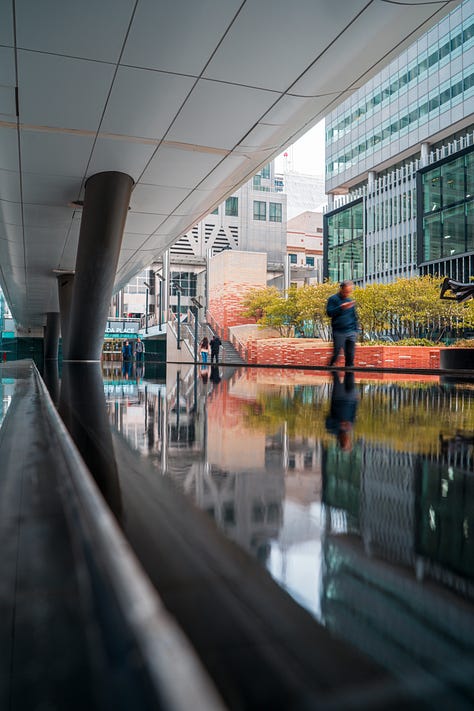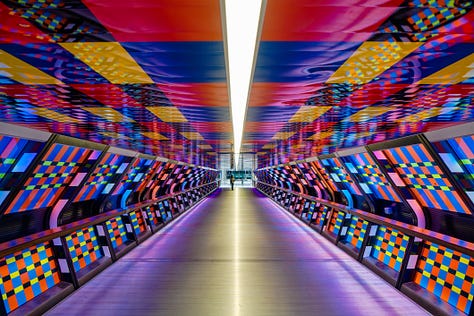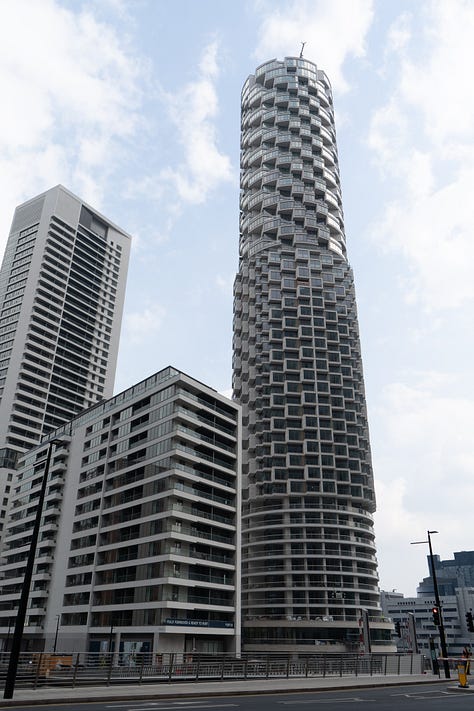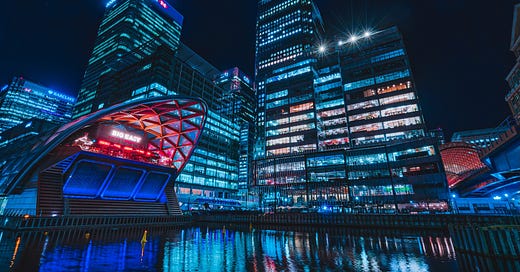Canary Wharf - A Continuous Urban Experiment
A living proof of how a neighbourhood continuously reinvents itself
Canary Wharf has always intrigued me as a London neighbourhood. It strives to embody the essence of Manhattan, Hong Kong, and Tokyo, yet falls short of achieving the same level of compactness, density, and vibrancy.
Over the years, I have had the opportunity to visit this part of London on numerous occasions. From its early days, when One Canada Square and the surrounding post-modernist buildings were erected to mimic the iconic Lower Manhattan, to the more recent expansion with the impressive HSBC headquarters designed by Fosters and Partners, and the ongoing residential developments in Wood Wharf, the neighbourhood has consistently captivated me. It continually reinvents itself, constantly striving to attract investors and tenants.
The location of the photograph is a well-known vantage point that perfectly captures the scale of development in Canary Wharf. Situated next to the North Dock, the body of water in the foreground acts as a reflective surface, beautifully mirroring the lights emanating from the towering skyscrapers. I had scouted this spot a few months earlier, but at the time, the lower floors of the building in the foreground were still undergoing their final fit-out stage. I made a mental note to return when the distraction of the construction site and its hoardings would no longer mar the composition.
In January, during the Canary Wharf Winter Lights Festival, I had the pleasure of photographing the captivating Floating Earth installation by Luke Jerram. That photo and the background story will be discussed in a separate post. However, that photo shoot also presented the perfect opportunity to revisit this location.
Having previously scouted the area, setting up the camera for the shot was a straightforward task. In terms of composition, there were two approaches I considered. The first involved using a wide-angle lens, pointing the camera upwards to capture the full height of the HSBC and One Canada Square buildings. This perspective created a visually striking effect, with the buildings appearing to lean backward, emphasising their grandeur and scale.
The alternative approach was to ensure the camera remained parallel to the buildings, avoiding any distortion. However, I felt this composition would lack the dramatic impact and overall strength of the final image I ultimately captured.
Regrettably, I did not have my filters with me to smooth out the water, but perhaps this serves as a sign for me to return in the future. This would allow me to seize another opportunity to capture a moment in time, particularly when the cityscape undergoes another transformation.
When it came to post-processing the photo, I found myself captivated by the cool white lights emanating from the office building. This reminded me of the iconic film, Bladerunner, where the cinematic colour grading accentuates the blue hues. Consequently, I took artistic license and enhanced the blue tones within the photo, resulting in a final image reminiscent of a futuristic cyber-punk movie or video game.
My experience with high-rise buildings and living in a high-density neighbourhood differs greatly from that of the majority of people in the UK. Having been born and raised in Hong Kong during my teenage years, I became accustomed to living and walking among skyscrapers as a normal part of daily life. It never fazed me. What surprises me, however, is the resistance to high-rise buildings in the majority of the UK, even in a world city such as London.
The development of Canary Wharf, in particular, stands out as a unique case. Conceived in the 1980s as an Enterprise Zone to stimulate development in the Docklands along the River Thames, it symbolised confidence and ambition at the time. Marketed as the "mini-Manhattan" of London, its ambition is to attract investment through substantial tax breaks.
However, this also resulted in the creation of an exclusive zone within the neighbourhood, especially when comparing its social and economic performance to neighbouring areas such as Poplar or Limehouse.
This type of capitalist, market-driven development is not new. However, the approach taken in Canary Wharf was less aggressive compared to similar developments in Hong Kong, where every centimetre is scrutinised meticulously. In Hong Kong, the ground floors of buildings often incorporate mixed-use spaces to maximize profits and enhance the diversity of land use. In contrast, the majority of buildings in Canary Wharf feature large and opulent private entrance lobbies.
Furthermore, the public realm in the surrounding area, including roads, pavements, parks, and public spaces, falls under the ownership of private landlords. As a result, the overall neighbourhood has become sterile, cold, and excessively controlled. All public spaces have been meticulously curated, lacking the freedom and vibrancy associated with dynamic neighbourhoods like Causeway Bay, the shopping district of Hong Kong, or Ginza/Shinjuku in Tokyo, where high-rise buildings coexist with a finer grain of ground-level developments.
There were clear indications of change during my time working in Canary Wharf prior to the pandemic. Residential tower blocks were being constructed, and there were also various events, such as the Winter Light Festival, and permanent public art installations. These initiatives were a response to the realisation that the neighbourhood lacked vitality and needed to undergo transformations to address this issue.



During my most recent visit to Canary Wharf, I observed a more diverse range of people visiting the area, including mothers with strollers. This suggested that the neighbourhood was reinventing itself to adapt to the evolving urban environment. The recent news of HSBC's departure from the area, relocating back to The City of London, further emphasised that the once highly sought-after location for corporate headquarters is losing its appeal. In order to remain relevant and attractive to investors, workers, tenants, and residents, Canary Wharf must reinvent itself and attract a different clientele.
As an urbanist, I have previously produced detailed masterplan drawings and reports for clients, aiming to provide a sense of certainty and a creative vision of what a place will or should look like in the next 10-20 years. However, the continuous experimentation and reinvention of Canary Wharf have taught me that certainty in development is never guaranteed. Instead, the role of a masterplan should focus on establishing development principles and creating a framework that can adapt to unforeseen changes in the future. It is crucial to ensure that the design principles are robust enough to accommodate these changes.
Thank you for taking the time to read this. I would greatly appreciate it if you could provide any comments or feedback you may have. If you are finding this content enjoyable, why not share it with someone you know who may also find it interesting? Your support is truly valued.
My photographs are published on Instagram and online. Additionally, I am available for private commissions and collaborations with other organisations. Please do not hesitate to reach out to me for further inquiries or opportunities.




